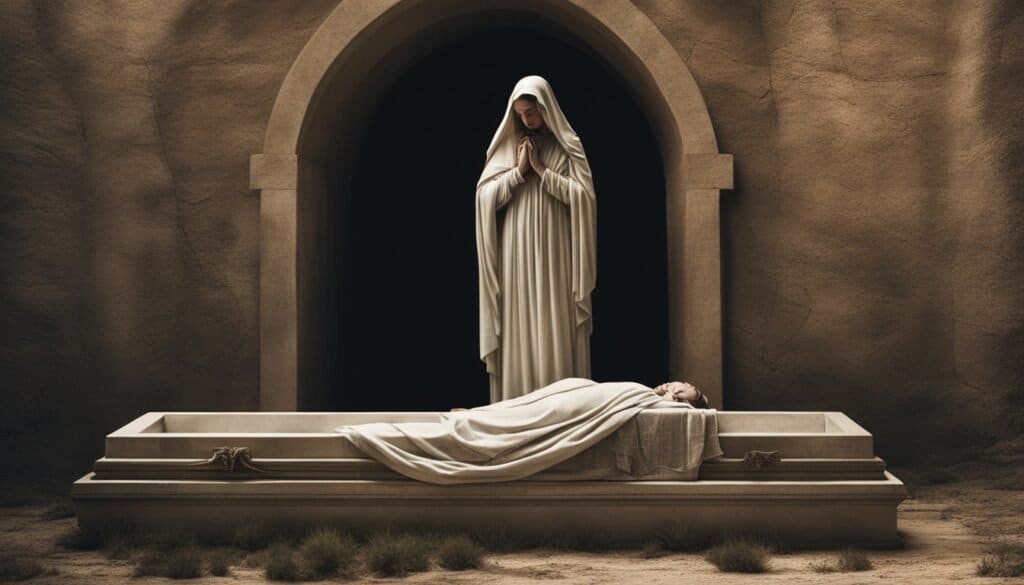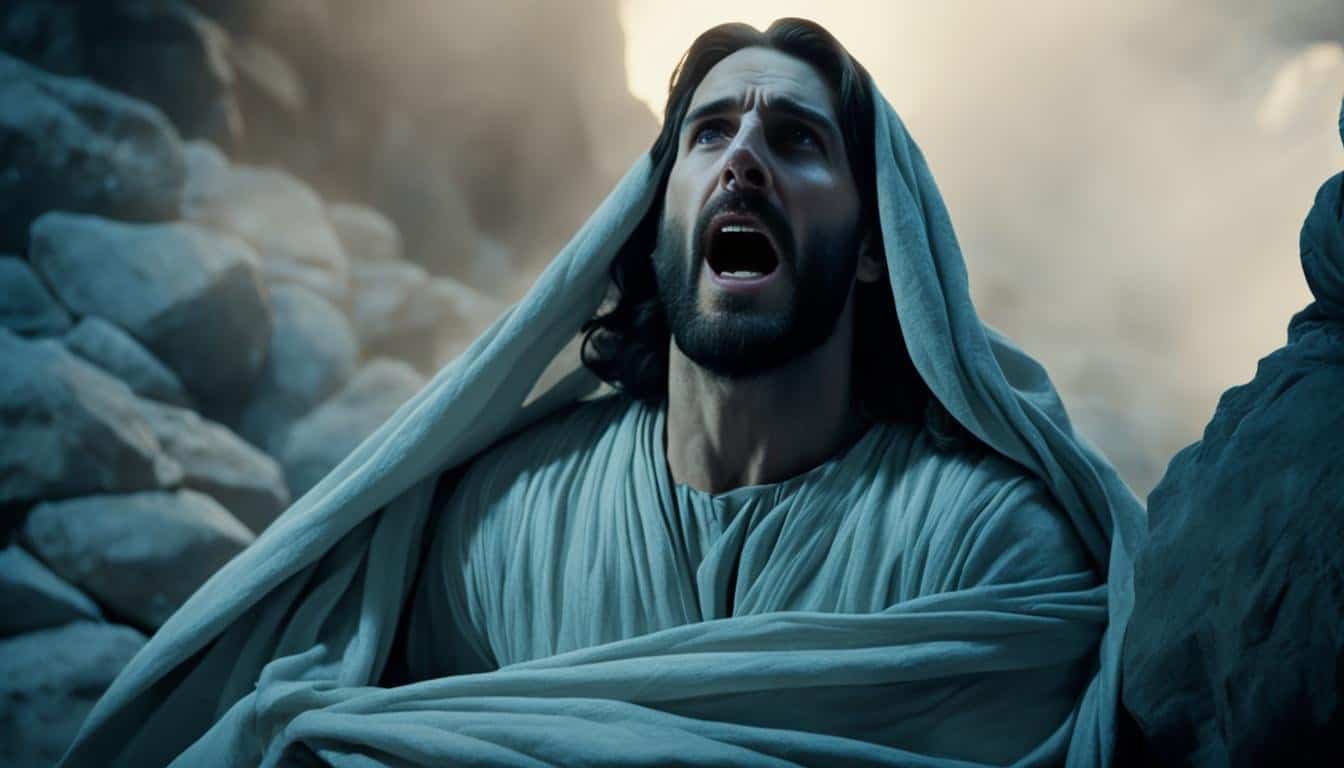Imagine if the story of Lazarus made us rethink life, death, and faith. This tale is more than an old story; it shows Jesus’ power over death. It gives us hope and connects us deeply with each other.
The story of Lazarus is a powerful lesson in faith and the power of divine timing. It teaches us about the miraculous nature of Christ and how it changed lives. Let’s explore this amazing story that still moves people today.
Key Takeaways
- The Lazarus resurrection illustrates Jesus’ authority over death.
- Mary and Martha’s faith exemplifies human emotion in times of grief.
- Divine timing plays a crucial role in the story.
- The miracle serves as a catalyst for belief among witnesses.
- Understanding the depth of compassion displayed by Jesus.
- The resurrection story has significant theological implications.
- The event mirrors other biblical miracles, enhancing its relevance.
The Story of Lazarus
The story of Lazarus is in John 11:1-44. It’s about a man loved by Jesus. We see how his resurrection and his sisters’ lives are connected. Their bond adds deep meaning to the story.
Overview of the Biblical Account
John 11:1-44 tells a powerful story. It starts with Lazarus getting sick. The story shows the hope of faith when facing death. Jesus shows compassion and power to the sisters, highlighting love, despair, and life’s victory over death.
The Key Characters in the Narrative
Lazarus is a key figure, showing us mortality and vulnerability. His sisters, Mary and Martha, show different ways to deal with grief. Mary shows deep sadness, while Martha talks with Jesus more logically. This shows how people feel differently but can still support each other.
The story of Lazarus teaches us about faith and spiritual lessons. For those interested in Jesus’ miracles and teachings, check out this link. The characters’ actions show how faith changes lives.
Jesus Receives the News
Lazarus gets very sick, and his sisters, Mary and Martha, feel a deep sense of urgency. They are very close to Jesus, which is clear in their message. They say, “Lord, behold, he whom thou lovest is sick” (John 11:3). This shows how serious Lazarus’s illness is and how much they need help.
The Sickness of Lazarus
Mary and Martha hear about Lazarus’s illness and are worried right away. They know Jesus can help because they are close to Him. They believe Jesus can make their brother better, showing their faith in tough times.
The Sisters’ Plea for Help
Mary and Martha ask Jesus for help with a lot of emotion. They’re not just telling Him about Lazarus; they’re asking Him to act. Their plea shows how much they believe in Jesus and how much they need Him.

| Character | Relationship to Lazarus | Key Action |
|---|---|---|
| Mary | Sister of Lazarus | Sends message to Jesus |
| Martha | Sister of Lazarus | Participates in the plea |
| Lazarus | Brother of Mary and Martha | Illness prompts the sisters’ action |
Jesus’ Delayed Arrival
The story of Jesus’ delayed arrival is very important, especially in John 11:6. When he learns about Lazarus’ illness, he decides to stay put for two more days. This choice, though puzzling, shows the value of timing in God’s plan for everyone.
The Significance of the Two-Day Wait
This two-day pause has many reasons. It shows that God’s timing is not like ours. Seeing this, we understand how delays can make the miraculous moments even more powerful. The wait gives us time to think, pray, and learn about God’s plans, changing how we see challenges.
Understanding Divine Timing
Thinking about divine timing teaches us about patience in our faith. Like Jesus, we often wait, trusting in a bigger plan. These times make us rely on faith, showing us that answers can come when we least expect them. This idea tells us our experiences have a bigger purpose, like Lazarus’ story. Understanding this helps us see the depth of our faith, showing us the value of waiting. Learn more about this here.
https://www.youtube.com/watch?v=iGwpgD39yGM
Jesus’ Declaration of Purpose
In John 11:4, the story of Lazarus’s illness takes a dramatic turn. Jesus says, “This sickness is not unto death, but for the glory of God.” This statement shows us that even in tragedy, there’s a bigger plan we can’t fully grasp.
The Sickness for the Glory of God
Lazarus’s illness is more than just a sad event. It’s a sign of God’s glory. Seeing it this way changes how we see things. Instead of just seeing the illness as bad luck, we start to think about how our troubles might have a deeper purpose.
Revelation of Jesus’ Mission
Looking closer at Jesus’ words, we see his true mission. He was here for a reason. By bringing Lazarus back to life, Jesus showed his strength and the glory of God. This act is a key moment that helps us understand Jesus better and why he came to us.

The Mourning of Mary and Martha
Lazarus’ death shows us how we all feel loss and sadness. Mary and Martha’s grief is clear when Mary says, “If thou hadst been here, my brother had not died” (John 11:32). Their words show how deep our emotional bonds are with those we lose.
Expressions of Grief and Despair
Mary and Martha’s grief is a common human feeling. It mirrors the emotional battles we all face. Their deep sadness connects with our own mourning experiences. It tells us it’s okay to feel and show our pain.
We learn that grief is different for everyone. But seeing their true pain helps us accept our own feelings. It’s comforting to know we’re not alone in our sorrow.
The Importance of Community Support
When we’re very sad, we see how important friends and family are. They come together to comfort us, just like they did for Mary and Martha. This shows how important it is to have people around us.
Together, we can get through tough times. Having a support network is key in mourning. It reminds us we’re not alone. This understanding can change how we deal with loss. We can support each other and feel like we belong.The mourning of Mary and Martha shows how being together helps us overcome grief.

Jesus Weeps
In the story of Lazarus, we see a moment when Jesus weeps. This brief verse, John 11:35, shows the deep compassion of Christ. Jesus’ tears let us into his heart, showing his deep care for human pain and loss.
The Deep Compassion of Christ
When Jesus comes to Lazarus’ tomb, he feels the deep sadness of Mary and Martha. The simple words “Jesus wept” show more than just a reaction to sorrow. They show a deep connection with those who are grieving. Jesus’ feelings show us that compassion of Christ is more than just feeling sorry for us. It’s about understanding and sharing our pain.
Thinking about this moment gives us strength. We know our Savior feels with us in our hard times. Feeling deeply is a natural part of being human. Jesus crying at Lazarus’ tomb reminds us that feeling together can help us heal and connect with others.

The Miracle of Resurrection
Jesus showed his power by bringing Lazarus back to life. His command, “Lazarus, come forth,” still moves us today. It shows us the power of resurrection (John 11:43-44).
This was more than just a call. It was a powerful statement that turned sadness into happiness.
The Command: “Lazarus, Come Forth”
Jesus’ command was powerful. Lazarus, thought to be dead, heard the Savior’s voice. Everyone watched as Jesus called out, “Lazarus, come forth.”
This moment showed us hope and the power of the divine.
The Immediate Aftermath of the Miracle
Lazarus came out of the tomb, still wrapped in his graveclothes. The crowd was amazed. They saw Jesus’ power over death firsthand.
This event made people think differently about faith and resurrection. It brought them closer to understanding Jesus and his power in our lives.
This miracle changed Lazarus and those around him. Let’s remember Jesus’ power as we explore these themes. For more insights, visit Jesus’ ministry.
The Impact on Belief
The resurrection of Lazarus was a big moment for faith. It changed many people’s lives. The miracle in John 11:45 made a big impact on belief.
This event didn’t just help Lazarus. It also changed how people saw Jesus. They realized Jesus had true power.
The Transformation of Witnesses
Seeing Lazarus come back to life changed many people. They went from just watching to being part of a faith movement. Many started believing in Jesus because of what they saw.
This shows us how our lives can change. And how we can help others change too.
Encouraging Faith in Christ
Seeing something amazing can make us stronger in our faith. Each story of change can remind us of our own hopes and beliefs. The story of Lazarus shows us how these moments can really change us.
The Plot Against Jesus
The raising of Lazarus was a key moment in Jesus’ ministry. It amazed and frightened people, leading to a big plot against Jesus by the religious leaders. In John 11:53, we learn how this miracle made leaders want to kill him, increasing the fight between faith and opposition.
The Increasing Opposition Following the Resurrection
The miracle of raising Lazarus didn’t go unnoticed. It scared the religious leaders who saw Jesus as a threat to their power. His growing popularity made people turn against the leaders, who felt their teachings and power were at risk.
This led to a big fight against Jesus. The leaders wanted to stop him because they saw him as a danger.
Consequences of the Miraculous Events
As things got more tense, people’s views split. Many believed in Jesus more, while others became even more against him. This led to big problems for Jesus’ work, as leaders planned to get rid of him.
This shows us how deep beliefs can make people resist us. Facing such opposition needs us to stay strong in our beliefs.
| Event | Outcome |
|---|---|
| Lazarus Raised from the Dead | Increased belief among followers |
| Religious Leaders’ Conspiracy | Plot to kill Jesus |
| Public Response | Division in opinions regarding Jesus |
| Growing Tension | Escalating opposition to Jesus |
Does the Story of Lazarus Provide Insight into the Concept of Resurrection and Judgment After Death?
The story of Lazarus offers a profound perspective on resurrection and judgment after death. By exploring Lazarus’s return to life, one gains valuable insights into understanding biblical views on judgment. This narrative illustrates themes of faith, divine authority, and the hope of eternal life, central to many religious beliefs.
Lazarus Resurrection: Symbolism and Significance
The resurrection of Lazarus is a key event in Christianity. Jesus said, “I am the resurrection, and the life” (John 11:25-26). This shows He is the source of eternal life. It tells us about our existence, death, and the hope faith gives us.
This event is more than just a show of power. It makes us think about our bond with Jesus. By bringing Lazarus back, we see God’s love and His plan for us. It teaches us about the power of faith and the peace it brings.
Lazarus’s story shows us the hope of our own resurrection. It reminds us of the promise of eternal life through faith. Understanding this story helps us grasp Jesus’ message deeply. It invites us to join a journey that changes us spiritually.
For more insights, we can look at other stories in the Bible. For example, the Transfiguration story also teaches us about faith and change.
Affiliate Disclosure: "As an Amazon Associate I earn from qualifying purchases made from links in this post. We are a participant in the Amazon Services LLC Associates Program, an affiliate advertising program designed to provide a means for us to earn fees by linking to Amazon.com."

